Review of Methodologies for the Assessment of Feasible Operating Regions at the TSO–DSO Interface
Abstract
:1. Introduction
1.1. Motivation
1.1.1. Challenges Posed by the Energy Transition
1.1.2. TSO–DSO Coordination Models
1.1.3. Feasible Operating Regions
1.1.4. Types of Flexibility-Providing Units at the Distribution Network
1.2. Similar Works and Contribution
- To provide a detailed review of the existing methods for the estimation of the FOR for all three available categories of methods (Geometric, RS and OB methods);
- To include the type of FPUs of the reviewed works;
- To examine whether the reviewed methods account for the time dependence some FPUs exhibit, and calculate the FOR for multiple time periods;
- To examine whether the reviewed methods can provide information regarding the monetization of the FOR; and
- To provide a comparison between the three categories of FOR estimation methods, focusing on their respective strengths and weaknesses, and make recommendations on the use cases that better suit each category of methods.
2. Geometric Methods
2.1. Overview
2.2. Related Works
2.3. Discussion
3. Random Sampling Methods
3.1. Overview
3.2. Related Works
3.3. Discussion
4. Optimization-Based Methods
4.1. Overview
4.1.1. Setpoint-Based Sampling
4.1.2. Angle-Based Sampling
4.2. Related Works
4.3. Discussion
5. Comparison of Feasible Operating Region Estimation Methods
6. Conclusions
Author Contributions
Funding
Institutional Review Board Statement
Informed Consent Statement
Data Availability Statement
Conflicts of Interest
References
- IRENA. Power System Flexibility for the Energy Transition, Part 1: Overview for Policy Makers; Elsevier B.V.: Amsterdam, The Netherlands, 2018; p. 48. [Google Scholar]
- European Commission. REPowerEU: A Plan to Rapidly Reduce Dependence on Russian Fossil Fuels and Fast Forward the Green Transition. Available online: https://ec.europa.eu/commission/presscorner/detail/en/IP_22_3131 (accessed on 3 June 2022).
- Hsieh, E.; Anderson, R. Grid flexibility: The quiet revolution. Electr. J. 2017, 30, 1–8. [Google Scholar] [CrossRef]
- Hong, T.; Pinson, P.; Wang, Y.; Weron, R.; Yang, D.; Zareipour, H. Energy Forecasting: A Review and Outlook. IEEE Open J. Power Energy 2020, 7, 376–388. [Google Scholar] [CrossRef]
- Impram, S.; Varbak Nese, S.; Oral, B. Challenges of renewable energy penetration on power system flexibility: A survey. Energy Strategy Rev. 2020, 31, 100539. [Google Scholar] [CrossRef]
- European Commission. Fit for 55. Available online: https://www.consilium.europa.eu/en/policies/green-deal/fit-for-55-the-eu-plan-for-a-green-transition/ (accessed on 3 June 2022).
- Farhangi, H. The path of the smart grid. IEEE Power Energy Mag. 2010, 8, 18–28. [Google Scholar] [CrossRef]
- Forouli, A.; Bakirtzis, E.A.; Papazoglou, G.; Oureilidis, K.; Gkountis, V.; Candido, L.; Ferrer, E.D.; Biskas, P. Assessment of Demand Side Flexibility in European Electricity Markets: A Country Level Review. Energies 2021, 14, 2324. [Google Scholar] [CrossRef]
- Jin, X.; Wu, Q.; Jia, H. Local flexibility markets: Literature review on concepts, models and clearing methods. Appl. Energy 2020, 261, 114387. [Google Scholar] [CrossRef] [Green Version]
- Directive (EU) 2019/944 of the European Parliament and of the Council of 5 June 2019 on Common Rules for the Internal Market for Electricity and Amending Directive 2012/27/EU (Text with EEA Relevance), Volume 158. 2019. Available online: http://data.europa.eu/eli/dir/2019/944/oj/eng (accessed on 7 April 2022).
- ENTSO-E. General Guidelines or Reinforcing the Cooperation between TSO and DSO; ENTSO-E: Brussels, Belgium, 2015. [Google Scholar]
- ENTSO-E. Distributed Flexibility and the Value of TSO/DSO Cooperation; ENTSO-E: Brussels, Belgium, 2017. [Google Scholar]
- CIGRE. System Operation Emphasizing DSO/TSO Interaction and Coordination. 2018. Available online: https://e-cigre.org/publication/733-system-operation-emphasizing-dsotso-interaction-and-coordination (accessed on 20 June 2022).
- Givisiez, A.G.; Petrou, K.; Ochoa, L.F. A Review on TSO-DSO Coordination Models and Solution Techniques. Electr. Power Syst. Res. 2020, 189, 106659. [Google Scholar] [CrossRef]
- Papavasiliou, A.; Mezghani, I. Coordination Schemes for the Integration of Transmission and Distribution System Operations. In Proceedings of the 2018 Power Systems Computation Conference (PSCC), Dublin, Ireland, 11–15 June 2018; pp. 1–7. [Google Scholar]
- Caramanis, M.; Ntakou, E.; Hogan, W.W.; Chakrabortty, A.; Schoene, J. Co-Optimization of Power and Reserves in Dynamic T&D Power Markets With Nondispatchable Renewable Generation and Distributed Energy Resources. Proc. IEEE 2016, 104, 807–836. [Google Scholar] [CrossRef]
- Koraki, D.; Strunz, K. Wind and Solar Power Integration in Electricity Markets and Distribution Networks Through Service-Centric Virtual Power Plants. IEEE Trans. Power Syst. 2018, 33, 473–485. [Google Scholar] [CrossRef]
- Kristov, L. The Bottom-Up (R)Evolution of the Electric Power System: The Pathway to the Integrated-Decentralized System. IEEE Power Energy Mag. 2019, 17, 42–49. [Google Scholar] [CrossRef]
- Sarstedt, M.; Kluß, L.; Gerster, J.; Meldau, T.; Hofmann, L. Survey and Comparison of Optimization-Based Aggregation Methods for the Determination of the Flexibility Potentials at Vertical System Interconnections. Energies 2021, 14, 687. [Google Scholar] [CrossRef]
- Heleno, M.; Soares, R.; Sumaili, J.; Bessa, R.J.; Seca, L.; Matos, M.A. Estimation of the flexibility range in the transmission-distribution boundary. In Proceedings of the 2015 IEEE Eindhoven PowerTech, Eindhoven, The Netherlands, 29 June 2015–2 July 2015; pp. 1–6. [Google Scholar]
- Sarstedt, M.; Hofmann, L. Monetarization of the Feasible Operation Region based on a Cost-Optimal Flexibility Disaggregation. IEEE Open Access J. Power Energy 2022, 10, 5402–5415. [Google Scholar] [CrossRef]
- Öztürk, E.; Rheinberger, K.; Faulwasser, T.; Worthmann, K.; Preißinger, M. Aggregation of Demand-Side Flexibilities: A Comparative Study of Approximation Algorithms. Energies 2022, 15, 2501. [Google Scholar] [CrossRef]
- Contreras, D.A.; Rudion, K. Computing the feasible operating region of active distribution networks: Comparison and validation of random sampling and optimal power flow based methods. IET Gener. Transm. Distrib. 2021, 15, 1600–1612. [Google Scholar] [CrossRef]
- Contreras, D.A.; Rudion, K. Improved Assessment of the Flexibility Range of Distribution Grids Using Linear Optimization. In Proceedings of the 2018 Power Systems Computation Conference (PSCC), Dublin, Ireland, 11–15 June 2018; pp. 1–7. [Google Scholar]
- Schneider, R. Convex Bodies: The Brunn–Minkowski Theory, 2nd ed.; Cambridge University Press: Cambridge, UK, 2013; ISBN 978-1-107-60101-7. [Google Scholar]
- Tiwary, H.R. On the Hardness of Computing Intersection, Union and Minkowski Sum of Polytopes. Discret. Comput. Geom. 2008, 40, 469–479. [Google Scholar] [CrossRef] [Green Version]
- Zhao, L.; Zhang, W.; Hao, H.; Kalsi, K. A Geometric Approach to Aggregate Flexibility Modeling of Thermostatically Controlled Loads. IEEE Trans. Power Syst. 2017, 32, 4721–4731. [Google Scholar] [CrossRef]
- Nazir, M.S.; Hiskens, I.A.; Bernstein, A.; Dall’Anese, E. Inner Approximation of Minkowski Sums: A Union-Based Approach and Applications to Aggregated Energy Resources. arXiv 2018, arXiv:1810.01587. [Google Scholar]
- Barot, S.; Taylor, J.A. A concise, approximate representation of a collection of loads described by polytopes. Int. J. Electr. Power Energy Syst. 2017, 84, 55–63. [Google Scholar] [CrossRef] [Green Version]
- Barot, S. Aggregate Load Modeling for Demand Response via the Minkowski Sum. Ph.D. Thesis, University of Toronto, Toronto, ON, Canada, 2017; p. 113. [Google Scholar]
- Barot, S.; Taylor, J.A. An outer approximation of the Minkowski sum of convex conic sets with application to demand response. In Proceedings of the 2016 IEEE 55th Conference on Decision and Control (CDC), Las Vegas, NV, USA, 12–14 December 2016; pp. 4233–4238. [Google Scholar]
- Muller, F.L.; Sundstrom, O.; Szabo, J.; Lygeros, J. Aggregation of energetic flexibility using zonotopes. In Proceedings of the 2015 54th IEEE Conference on Decision and Control (CDC), Osaka, Japan, 15–18 December 2015; pp. 6564–6569. [Google Scholar]
- Muller, F.L.; Szabo, J.; Sundstrom, O.; Lygeros, J. Aggregation and Disaggregation of Energetic Flexibility From Distributed Energy Resources. IEEE Trans. Smart Grid 2019, 10, 1205–1214. [Google Scholar] [CrossRef] [Green Version]
- Kundu, S.; Kalsi, K.; Backhaus, S. Approximating Flexibility in Distributed Energy Resources: A Geometric Approach. In Proceedings of the 2018 Power Systems Computation Conference (PSCC), Dublin, Ireland, 11–15 June 2018; pp. 1–7. [Google Scholar]
- Bernstein, A.; Le Boudec, J.-Y.; Paolone, M.; Reyes-Chamorro, L.; Saab, W. Aggregation of power capabilities of heterogeneous resources for real-time control of power grids. In Proceedings of the 2016 Power Systems Computation Conference (PSCC), Genoa, Italy, 20–24 June 2016; pp. 1–7. [Google Scholar]
- Hao, H.; Sanandaji, B.M.; Poolla, K.; Vincent, T.L. A generalized battery model of a collection of Thermostatically Controlled Loads for providing ancillary service. In Proceedings of the 2013 51st Annual Allerton Conference on Communication, Control, and Computing (Allerton), Monticello, IL, USA, 2–4 October 2013; pp. 551–558. [Google Scholar]
- Hao, H.; Sanandaji, B.M.; Poolla, K.; Vincent, T.L. Aggregate Flexibility of Thermostatically Controlled Loads. IEEE Trans. Power Syst. 2015, 30, 189–198. [Google Scholar] [CrossRef]
- Mayorga Gonzalez, D.; Hachenberger, J.; Hinker, J.; Rewald, F.; Häger, U.; Rehtanz, C.; Myrzik, J. Determination of the Time-Dependent Flexibility of Active Distribution Networks to Control Their TSO-DSO Interconnection Power Flow. In Proceedings of the 2018 Power Systems Computation Conference (PSCC), Dublin, Ireland, 11–15 June 2018; pp. 1–8. [Google Scholar]
- Riaz, S.; Mancarella, P. On Feasibility and Flexibility Operating Regions of Virtual Power Plants and TSO/DSO Interfaces. In Proceedings of the 2019 IEEE Milan PowerTech, Milan, Italy, 23–27 June 2019; pp. 1–6. [Google Scholar]
- Ageeva, L.; Majidi, M.; Pozo, D. Analysis of Feasibility Region of Active Distribution Networks. In Proceedings of the 2019 International Youth Conference on Radio Electronics, Electrical and Power Engineering (REEPE), Moscow, Russia, 14–15 March 2019; pp. 1–5. [Google Scholar]
- Thomas, M.; Raina, R. Load Flow Solution for Unbalanced Radial Power Distribution using Monte-Carlo Simulation. WSEAS Trans. Power Syst. 2014, 9, 7. [Google Scholar]
- Gerster, J.; Sarstedt, M.; Veith, E.; Lehnhoff, S.; Hofmann, L. Pointing Out the Convolution Problem of Stochastic Aggregation Methods for the Determination of Flexibility Potentials at Vertical System Interconnections. arXiv 2021, arXiv:2102.03430. [Google Scholar]
- Bremer, J.; Sonnenschein, M. Sampling the Search Space of Energy Resources for Self-organized, Agent-based Planning of Active Power Provision. In Proceedings of the EnviroInfo, Hamburg, Germany, 2–4 September 2013. [Google Scholar]
- Hinrichs, C.; Sonnenschein, M. A distributed combinatorial optimisation heuristic for the scheduling of energy resources represented by self-interested agents. Int. J. Bio-Inspired Comput. 2017, 10, 69. [Google Scholar] [CrossRef]
- Contreras, D.A.; Rudion, K. Verification of Linear Flexibility Range Assessment in Distribution Grids. In Proceedings of the 2019 IEEE Milan PowerTech, Milan, Italy, 23–27 June 2019; pp. 1–6. [Google Scholar]
- Chiodo, E.; Losi, A.; Mongelluzzo, R.; Rossi, F. Capability chart for electrical power systems. IEE Proc. 1992, 139, 71–75. [Google Scholar] [CrossRef]
- Rossi, M.; Viganò, G.; Moneta, D.; Vespucci, M.T.; Pisciella, P. Fast estimation of equivalent capability for active distribution networks. CIRED Open Access Proc. J. 2017, 2017, 1763–1767. [Google Scholar] [CrossRef]
- Viganò, G.; Rossi, M.; Moneta, D. Effects of distribution system characteristics on tso-dso ancillary services exchange. In Proceedings of the CIRED 2019, Madrid, Spain, 3–6 June 2019; p. 5. [Google Scholar]
- Silva, J.; Sumaili, J.; Bessa, R.J.; Seca, L.; Matos, M.A.; Miranda, V.; Caujolle, M.; Goncer, B.; Sebastian-Viana, M. Estimating the Active and Reactive Power Flexibility Area at the TSO-DSO Interface. IEEE Trans. Power Syst. 2018, 33, 4741–4750. [Google Scholar] [CrossRef]
- Fonseca, N.; Silva, J.; Silva, A.; Sumaili, J.; Seca, L.; Bessa, R.; Pereira, J.; Matos, M.; Matos, P.; Morais, A.C.; et al. EvolvDSO grid management tools to support TSO-DSO cooperation. In Proceedings of the CIRED Workshop 2016, Helsinki, Finland, 14–15 June 2016; p. 72. [Google Scholar]
- Yang, Z.; Zhong, H.; Xia, Q.; Bose, A.; Kang, C. Optimal power flow based on successive linear approximation of power flow equations. IET Gener. Transm. Distrib. 2016, 10, 3654–3662. [Google Scholar] [CrossRef]
- Contreras, D.A.; Rudion, K. Impact of Grid Topology and Tap Position Changes on the Flexibility Provision from Distribution Grids. In Proceedings of the 2019 IEEE PES Innovative Smart Grid Technologies Europe (ISGT-Europe), Bucharest, Romania, 29 September–2 October 2019; pp. 1–5. [Google Scholar]
- Contreras, D.; Laribi, O.; Banka, M.; Rudion, K. Assessing the Flexibility Provision of Microgrids in MV Distribution Grids; AIM: New York, NY, USA, 2018; ISBN 978-2-9602415-1-8. [Google Scholar]
- Contreras, D.A.; Rudion, K. Time-Based Aggregation of Flexibility at the TSO-DSO Interconnection Point. In Proceedings of the 2019 IEEE Power & Energy Society General Meeting (PESGM), Atlanta, GA, USA, 4–8 August 2019; pp. 1–5. [Google Scholar]
- Lopez, L.; Gonzalez-Castellanos, A.; Pozo, D.; Roozbehani, M.; Dahleh, M. QuickFlex: A Fast Algorithm for Flexible Region Construction for the TSO-DSO Coordination. arXiv 2021, arXiv:2107.00114. [Google Scholar]
- Baran, M.E.; Wu, F.F. Optimal capacitor placement on radial distribution systems. IEEE Trans. Power Deliv. 1989, 4, 725–734. [Google Scholar] [CrossRef]
- Barber, C.B.; Dobkin, D.P.; Huhdanpaa, H. The quickhull algorithm for convex hulls. ACM Trans. Math. Softw. 1996, 22, 469–483. [Google Scholar] [CrossRef] [Green Version]
- Capitanescu, F. TSO–DSO interaction: Active distribution network power chart for TSO ancillary services provision. Electr. Power Syst. Res. 2018, 163, 226–230. [Google Scholar] [CrossRef]
- Capitanescu, F. AC OPF-Based Methodology for Exploiting Flexibility Provision at TSO/DSO Interface via OLTC-Controlled Demand Reduction. In Proceedings of the 2018 Power Systems Computation Conference (PSCC), Dublin, Ireland, 11–15 June 2018; pp. 1–6. [Google Scholar]
- Stanković, S.; Söder, L.; Hagemann, Z.; Rehtanz, C. Reactive Power Support Adequacy at the DSO/TSO Interface. Electr. Power Syst. Res. 2021, 190, 106661. [Google Scholar] [CrossRef]
- Silva, J.; Sumaili, J.; Bessa, R.J.; Seca, L.; Matos, M.; Miranda, V. The challenges of estimating the impact of distributed energy resources flexibility on the TSO/DSO boundary node operating points. Comput. Oper. Res. 2018, 96, 294–304. [Google Scholar] [CrossRef]
- Bolfek, M.; Capuder, T. An analysis of optimal power flow based formulations regarding DSO-TSO flexibility provision. Int. J. Electr. Power Energy Syst. 2021, 131, 106935. [Google Scholar] [CrossRef]
- Chen, H.; Moser, A. Improved flexibility of active distribution grid by remote control of renewable energy sources. In Proceedings of the 2017 6th International Conference on Clean Electrical Power (ICCEP), Santa Margherita Ligure, Italy, 27–29 June 2017; pp. 280–284. [Google Scholar]
- Polymeneas, E.; Meliopoulos, S. Aggregate modeling of distribution systems for multi-period OPF. In Proceedings of the 2016 Power Systems Computation Conference (PSCC), Genoa, Italy, 20–24 June 2016; pp. 1–8. [Google Scholar]
- Kryonidis, G.C.; Lois, A.N.; Malamaki, K.-N.D.; Demoulias, C.S. Two-stage Approach for the Provision of Time-Dependent Flexibility at TSO-DSO Interface. In Proceedings of the 2021 International Conference on Smart Energy Systems and Technologies (SEST), Vaasa, Finland, 6–8 September 2021; pp. 1–6. [Google Scholar]
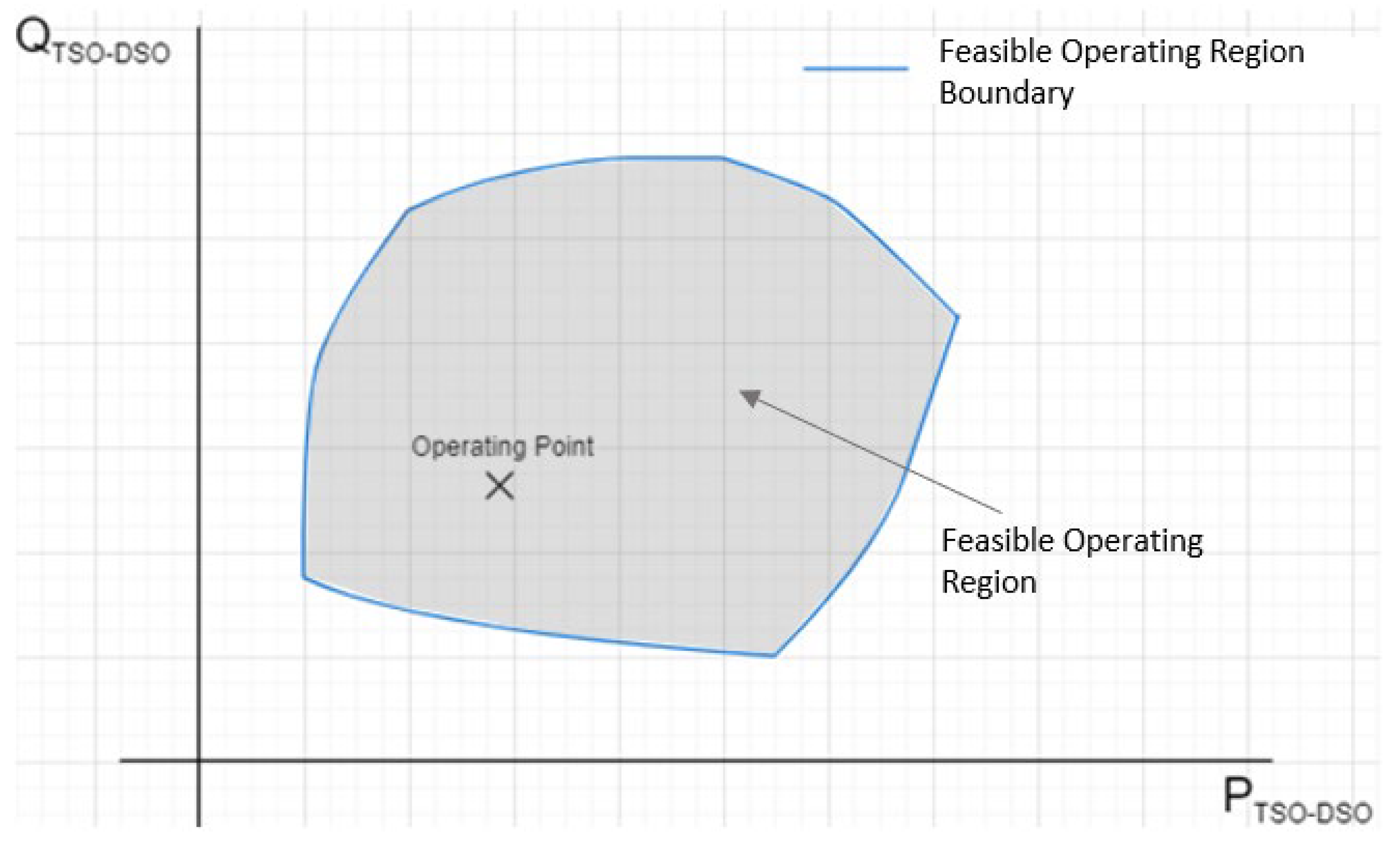

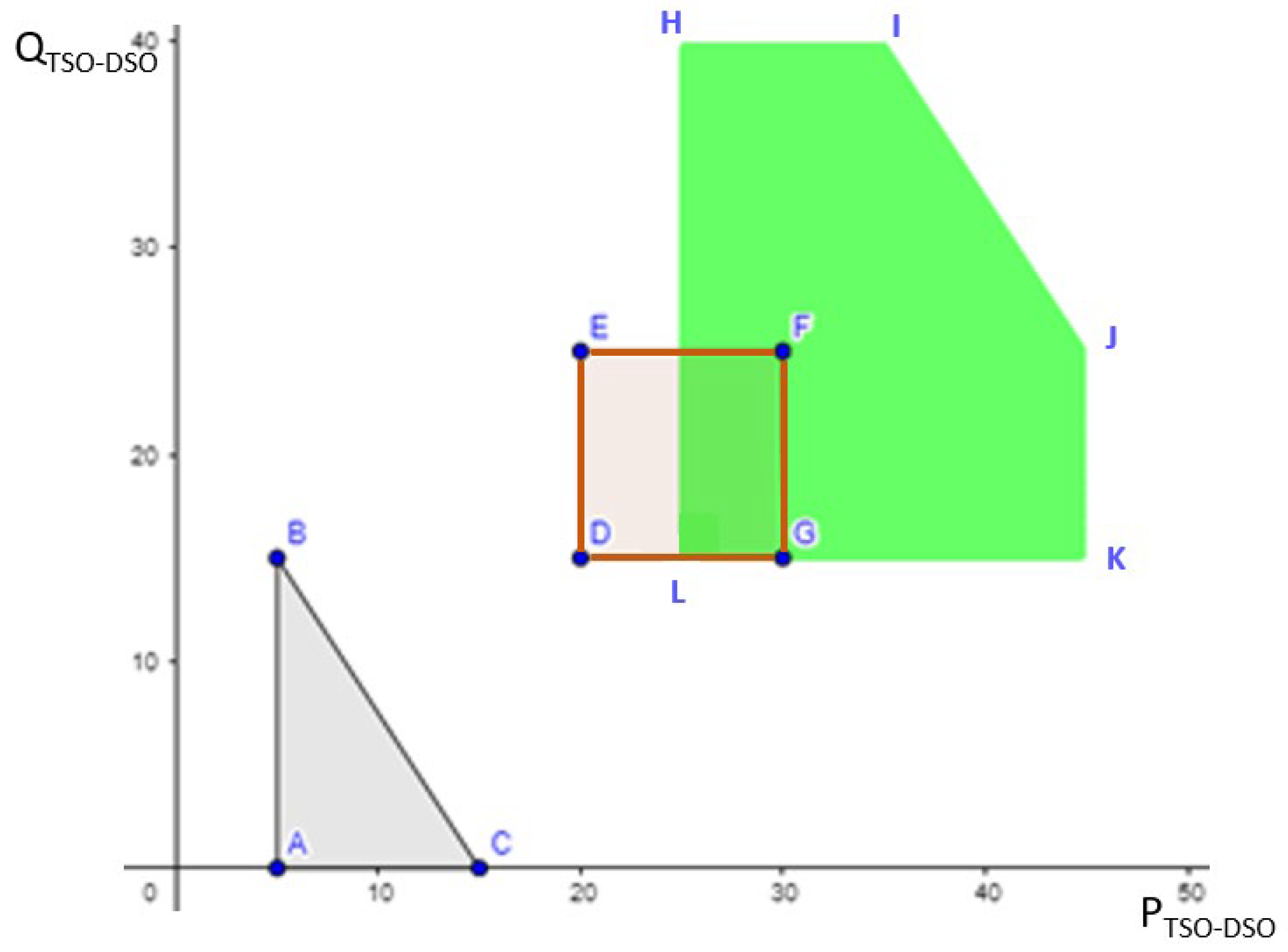
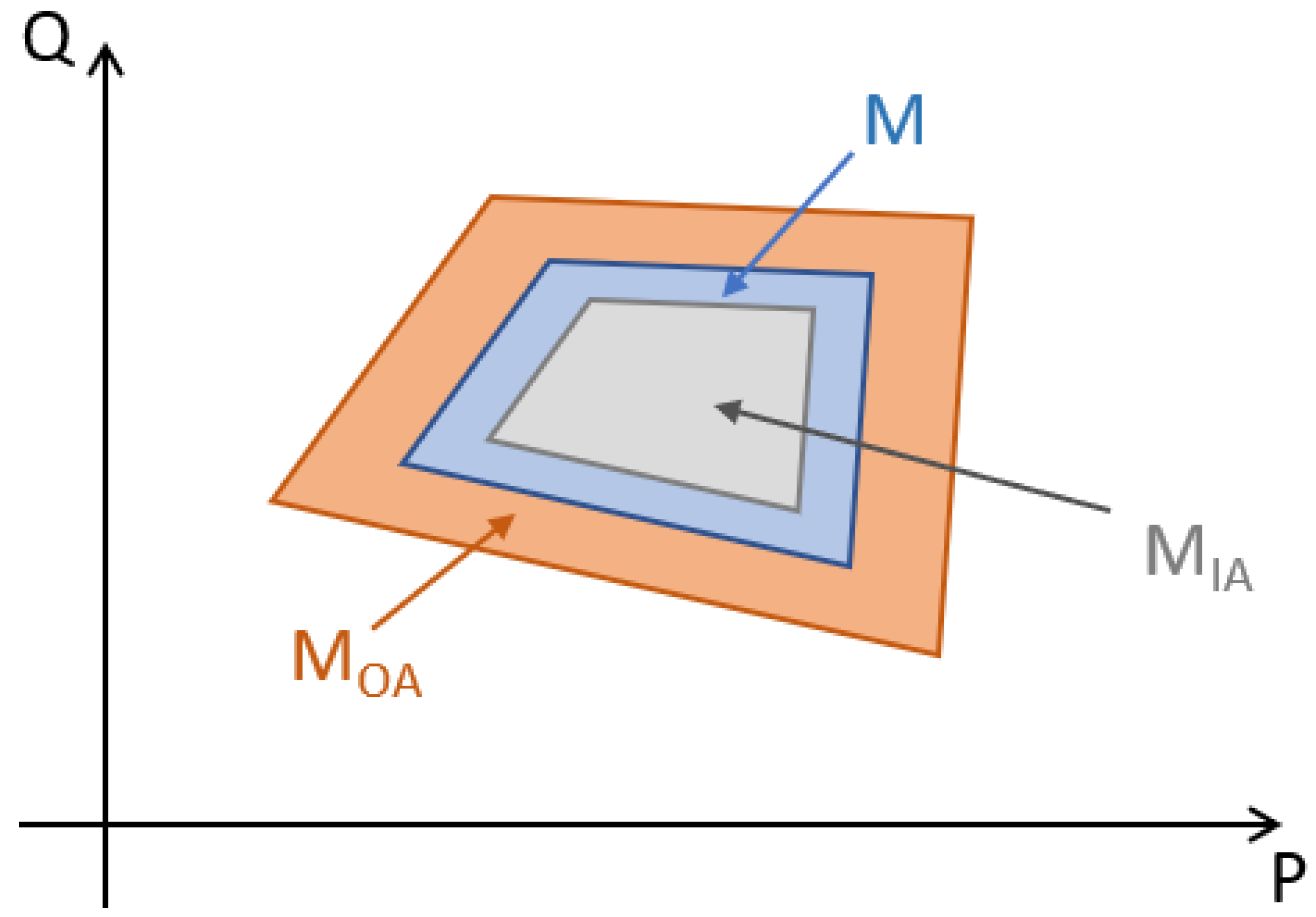

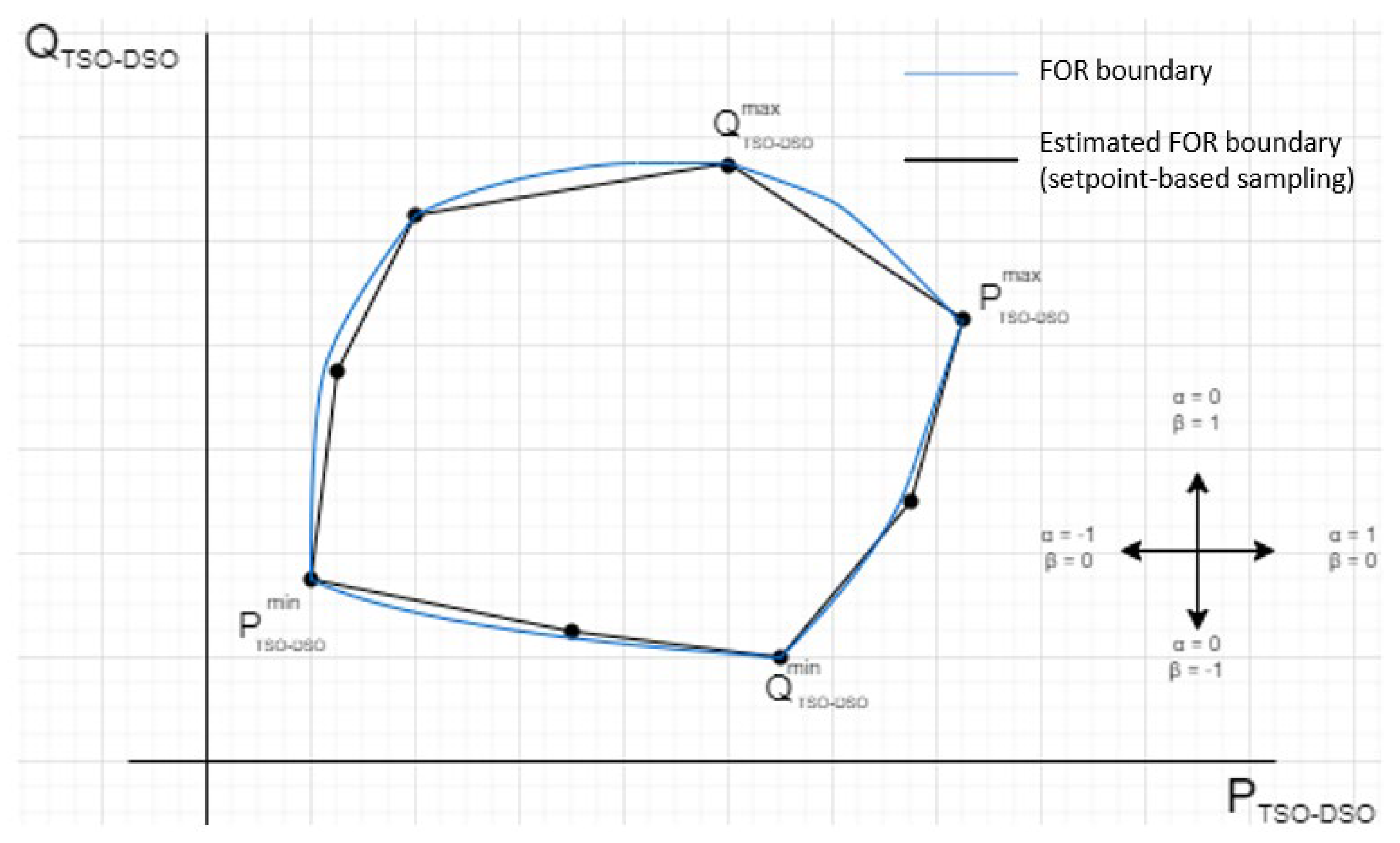
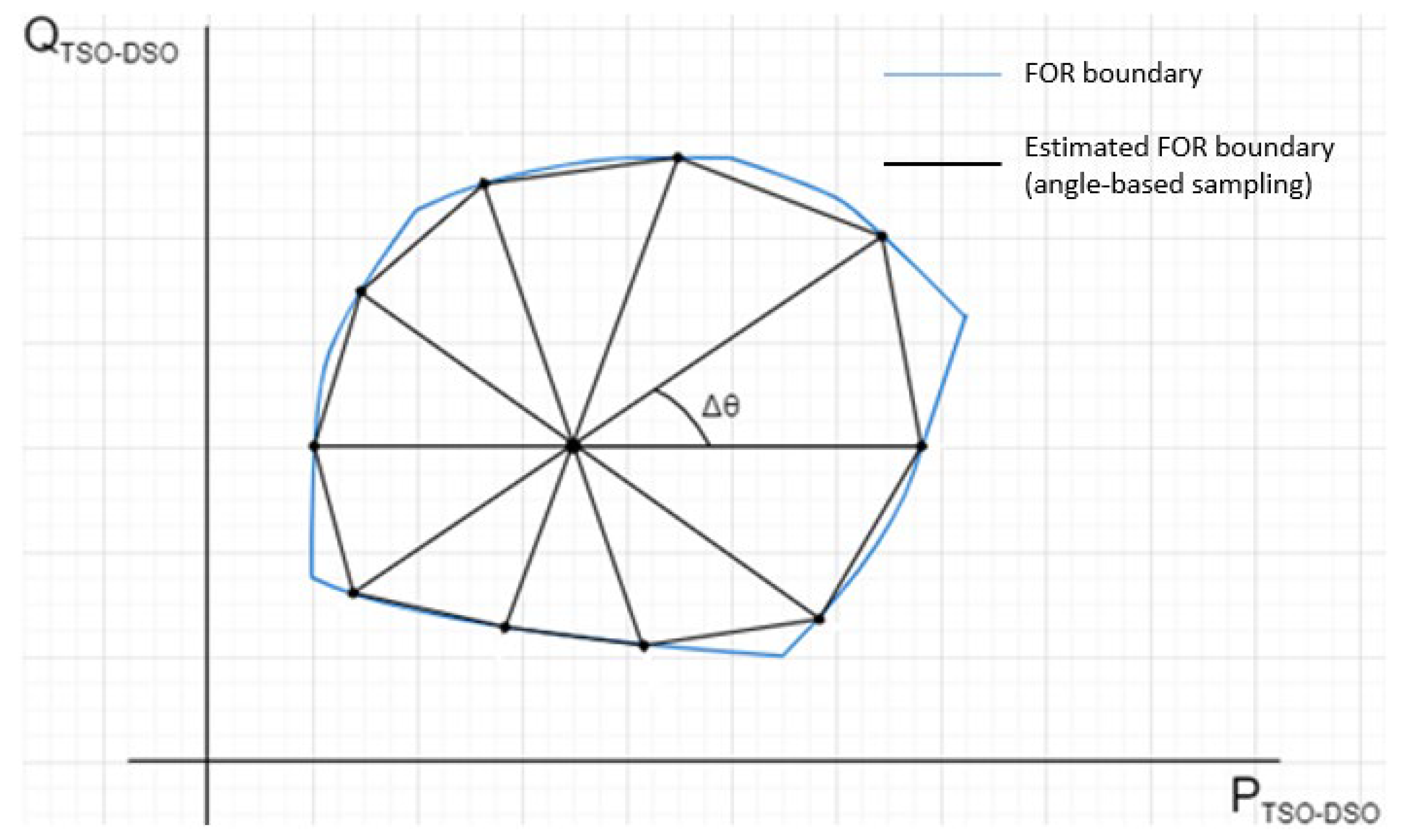
| Reference | FOR Estimation Categories Reviewed | Types of FPUs Analyzed | Time Dependence Examined | Monetization of FOR Examined |
|---|---|---|---|---|
| [19] | RS OB | No | No | Yes |
| [22] | Geometric | Yes | Yes | No |
| [23] | Geometric RS OB | Yes | No | No |
| This work | Geometric RS OB | Yes | Yes | Yes |
| Reference | Method | Type of FPUs Supported | Multi-Period Support | Monetization of FOR |
|---|---|---|---|---|
| [27] | IA and OA of M-sum | TCLs | No | No |
| [28] | IA of M-sum (zonotope and homothet-based) | Inverter-interfaced loads and TCLs | No | No |
| [29] | OA of M-sum | FPUs that can be modeled as convex polytopes | Yes | No |
| [30,31] | OA of M-sum | FPUs that can be modeled by linear, second-order cone or semidefinite constraints | Yes | No |
| [32] | Zonotope-based IA of M-sum | FPUs that can be modeled by linear constraints | Yes | No |
| [33] | Zonotope-based IA of M-sum | FPUs that can be modeled by linear constraints | Yes | Yes |
| [34] | Homothet-based OA and IA of M-sum | FPU-agnostic | Yes | No |
| [35] | M-sum | FPU-agnostic | No | Yes |
| [36,37] | Homothet-based OA and IA of M-sum modelled as virtual battery | TCLs | Yes | No |
| Reference | Method | Type of FPUs Supported | Multi-Period Support | Monetization of FOR |
|---|---|---|---|---|
| [20] | RS with independent random variables or negative correlation between loads and generation | FPU-agnostic | Yes | Yes |
| [38] | RS with independent random variables and time dependence | FPU-agnostic | Yes | No |
| [39] | RS with independent random variables and time dependence | FPU-agnostic | Yes | No |
| [40] | RS with PDFs from [41] | FPU-agnostic | No | No |
| [42] | RS with independent random variables | FPU-agnostic | No | No |
| [45] | RS with “beta” PDF | FPU-agnostic | No | No |
| [23] | RS with bivariate beta PDF and RS with Rademacher PDF | FPU-agnostic | No | No |
| Reference | Method | Type of FPUs Supported | Multi-Period Support | Monetization of FOR |
|---|---|---|---|---|
| [47] | OB angle sampling OB setpoint sampling OB quadratic | FPU-agnostic | No | No |
| [48] | OB angle sampling | FPU-agnostic | No | No |
| [49,50] | Iterative OB setpoint sampling with distance-based stopping criterion | Loads, generators, OLTC transformers and voltage compensators | Yes | No |
| [24,52,53,60] | Linearized Iterative OB setpoint sampling with distance-based stopping criterion | FPUs with small capacity, loads with constant cosφ, wind, photovoltaic and synchronous generators, OLTC transformers | No | No |
| [54] | Linearized Iterative OB setpoint sampling with distance-based stopping criterion | Photovoltaic and wind generators, storage systems | Yes | No |
| [55] | QuickFlex | FPU-agnostic | No | No |
| [58] | Iterative OB setpoint sampling with fixed sample size | FPU-agnostic | No | No |
| [59] | Iterative OB setpoint sampling with fixed sample size | OLTC transformers | No | No |
| [61] | Iterative OB angle sampling with angle-based stopping criterion | FPU-agnostic and OLTC transformers | No | No |
| [62] | Convexified Iterative OB setpoint sampling with distance-based stopping criterion | OLTC transformers, variable loads, generators, and voltage-sensitive loads | No | No |
| [63] | Iterative OB setpoint sampling | Inverter-interfaced RES | No | No |
| [64] | Ellipsoidal FOR model | Linear modeling of FPUs | Yes | No |
| [65] | Two-stage approach | Inverter-interfaced RES, batteries | Yes | No |
| [19] | Iterative OB setpoint-based sampling, solved with PSO | FPU-agnostic | No | Yes |
| [21] | Iterative OB setpoint-based sampling, solved with PSO | FPU-agnostic | No | Yes |
| Geometric Methods | RS Methods | OB Methods | |
|---|---|---|---|
| Advantages | -Can be used to aggregate FPUs connected at the same bus in RS and OB methods | -Easy to implement -Parallelizable -Accurately captures the physics of the system -Easy to include most types of FPUs -Straightforward monetization of the FOR -Parallelizable | -Very accurate -Able to capture intertemporal constraints of flexibility -Can provide monetization of the FOR |
| Disadvantages | -Exact M-Sum very computationally expensive -OA and IA approximations not accurate enough -Does not capture the physics of the DN | -No guarantees of accuracy, even with large sample sizes -Heavy computational burden -Lack of efficient sampling strategies and convolution problem -Inclusion of time dependence of flexibility is difficult | -Need to balance trade-off between accuracy and efficiency -Some formulations may limit the inclusion of certain types of FPUs -Not always parallelizable -Complex implementation |
Publisher’s Note: MDPI stays neutral with regard to jurisdictional claims in published maps and institutional affiliations. |
© 2022 by the authors. Licensee MDPI, Basel, Switzerland. This article is an open access article distributed under the terms and conditions of the Creative Commons Attribution (CC BY) license (https://creativecommons.org/licenses/by/4.0/).
Share and Cite
Papazoglou, G.; Biskas, P. Review of Methodologies for the Assessment of Feasible Operating Regions at the TSO–DSO Interface. Energies 2022, 15, 5147. https://doi.org/10.3390/en15145147
Papazoglou G, Biskas P. Review of Methodologies for the Assessment of Feasible Operating Regions at the TSO–DSO Interface. Energies. 2022; 15(14):5147. https://doi.org/10.3390/en15145147
Chicago/Turabian StylePapazoglou, Georgios, and Pandelis Biskas. 2022. "Review of Methodologies for the Assessment of Feasible Operating Regions at the TSO–DSO Interface" Energies 15, no. 14: 5147. https://doi.org/10.3390/en15145147
APA StylePapazoglou, G., & Biskas, P. (2022). Review of Methodologies for the Assessment of Feasible Operating Regions at the TSO–DSO Interface. Energies, 15(14), 5147. https://doi.org/10.3390/en15145147







